Twill Blocks on Four Shafts
Marcy Petrini
November, 2018
When we think of twill blocks, we generally don’t mean on four shafts, but I was intrigued by the “Twill Blocks No. 2” in Marguerite Porter Davison’s book A Handweaver’s Pattern Book (page 31 of 1994 revised edition – but I don’t see a No. 1!), so I decided I would weave a scarf using treadling II.
I always do a drawdown for my projects and good thing I did! Using the exact directions in the book, my drawdown looks like this:
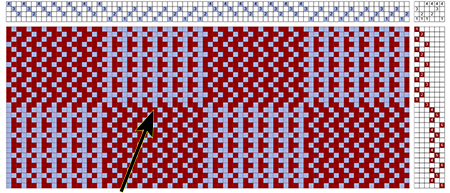
Click here for the full-sized draft (a PDF will open a new window)
At first I thought I had made a mistake, but, no, the error wasn’t mine. Length-wise warp floats appear in one block from shaft 1 always being raised, and on shaft 4 in the other block. In order to weave it, I would have to modify the tie-up to avoid the long warp floats.
The solution is to remove shaft 1 from one of the treadles for the 1st block and, similarly, remove shaft 4 from one of the treadles for the 2nd block.
I chose to detach the appropriate shaft from the 2nd treadle of each block. Here is the drawdown I used, but the solution is not unique, other combinations could be used.

Click here for the full-sized draft (a PDF will open a new window)
And here is a close-up of the fabric.
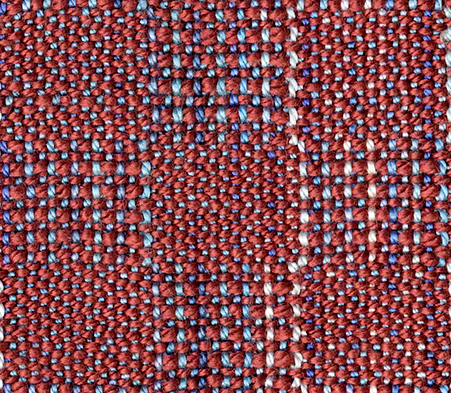
For another possibility, I thought it may be fun to have the blocks alternate a 2/1 straight twill; here is the drawdown. With 6 treadles, this is easier to weave.
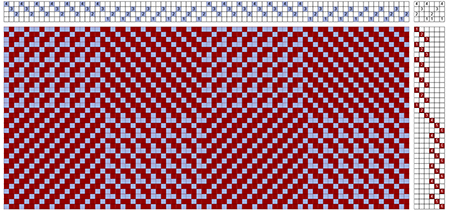
Click here for the full-sized draft (a PDF will open a new window)
And here is a close-up of the fabric.
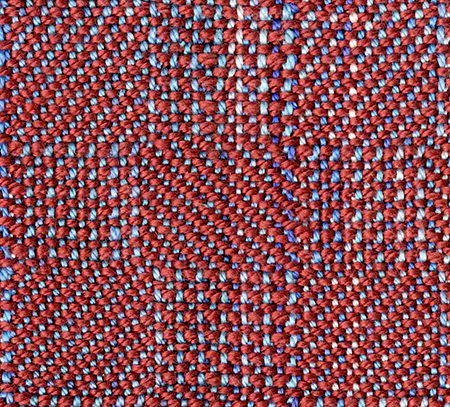
These blocks are so subtle that they are difficult to see while weaving, so I used the old lace knitting trick, the lifeline, and placed a sewing thread in the same shed as the first shot of the block.
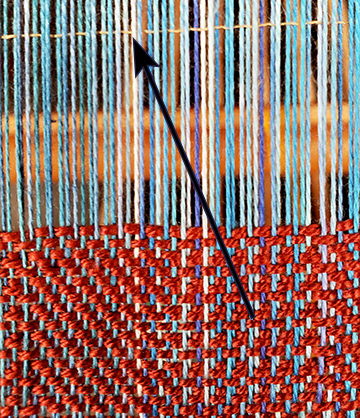
Starting from the sewing thread, I could then easily count how many shots I had woven for the given block; at the end of the block, I removed the sewing thread and placed it at the beginning of the next block.
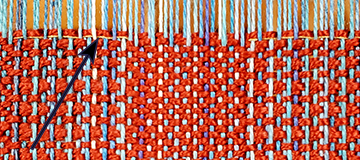
I used a strand of sewing thread long on both sides of the weaving edges to give me mechanical advantage in pulling it out after the weaving; to avoid the long thread getting in the way, I temporarily tacked it down with blue painter’s tape.

I used one set of blocks on each end of the scarf, but for the middle, I wanted the design to be more flowing, so I wove it with a straight draw which results in stripes of right-hand and left-hand broken twill lines. Here is the drawdown:

Click here for the full-sized draft (a PDF will open a new window)
And a close up of the fabric.
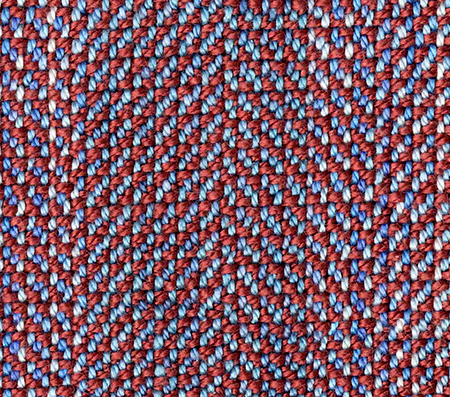
If you have never woven twill blocks on 4 shafts, give them a try!
Happy weaving!
Please email comments and questions to
Piqué in the Pictionary
Marcy Petrini
October, 2018
I learned about piqué from a workshop by Donna Sullivan who had just written her book, Pique: Plain and Patterned. While some fancy fabrics require more shafts, on four it is possible to weave plain piqué, also called ribbed, with either a loose-back or a fast-back.
The Pictionary now has a piqué page, but here is some of the information. There are two warps; the first forms a balanced cloth by interlacing with a weft of the same size; they are called the face warp and weft, in the picture below in yellow.
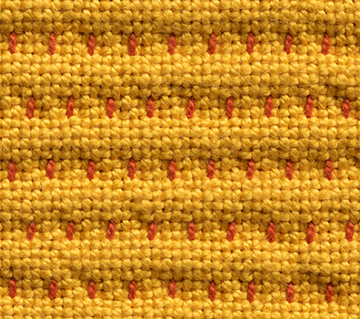
The orange warp is a stitcher warp, tensioned separately and tightly, which causes the characteristic puckering of the fabric. The ridges are made more prominent by using a stuffer weft, the beige fluffy wool, only visible in the back of the fabric shown below.
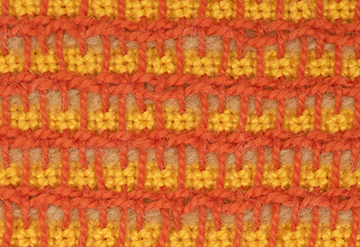
With two warps and two wefts, the piqué is called loose-back – because it is! In the fabric above, however, there is an additional weft, orange, which interlaces with the stitcher warp, making the fabric a fast-back piqué; even the fast-back is not totally stable, but it would be suitable for any fabric whose back is not exposed, a pillow, or a lined jacket.
In summary: ribbed or plain piqué has always two warps, face and stitcher; the loose-back has two wefts, the face and stuffer; the fast-back has three wefts: face, stuffer, and the stabilizing weft interlacing the stitcher warp.
Pictionary Update
- All of the Convergence® entries are in the Pictionary now, in addition to the few added since:
- piqué in October,
- canvas and (corrected) crepe in September,
- crepe twill in August,
- ribbed twill in July.
- More will be added with time, including shadow weave.
- Meanwhile, here is a quick test whose answers are in the Pictionary:
- Is tabby another name for plain weave?
- What is a fancy twill?
- Do I need to rethread my overshot to change from star to rose fashion?
- What’s the difference between “paired x’s” and “paired o’s” in summer and winter?
- Can I weave waffle weave on four shafts?
Enjoy!
and
Happy weaving!
Please email comments and questions to
Canvas and Crepe
Marcy Petrini
September, 2018
A long time ago, in a galaxy far, far away, in some workshop, I picked up the mistaken notion that canvas weave and crepe weave are related, or maybe even similar. Surprisingly and embarrassingly, I never checked that fact and I kept on weaving crepe weave, calling it canvas and even teaching it.
Recently, when I found a crepe twill, I started wondering what made it a crepe twill. That’s when I finally figure it all out, including why my mistaken notion probably started.
A crepe weave is a treadling method that aims to produce a crepe fabric, which is generally obtained from highly twisted crepe yarns. What makes the cloth from this structure behave similarly to a crepe fabric is the alternating plain weave shots with picks of floats.
The drawdown below shows the “on opposite” tie-up: the pick of 1 & 2 is followed by its opposite 3 & 4, forming two-thread floats; those are followed by the plain weave shots, 2 & 4 vs. 1 & 3, which are also “on opposite: the second pick uses the shafts not used by the first.

Click here for the full-sized draft (a PDF will open a new window)
The fabric shows the characteristic ridges formed by alternating the two on-opposite combinations of treadling.

Below is the drawdown for a crepe twill from Davison’s book. It doesn’t seem to have much in common with the crepe weave, except that it does form 2- and 3-thread floats that may cause the fabric to behave like a crepe cloth.

Click here for the full-sized draft (a PDF will open a new window)
The threading is unusual and the tie-up and treadling are that of a straight draw. The fabric is below.

Compared to the crepe weave fabric, that of the crepe twill seemed to be turned on its side: what if I turned the draft?
Below is the crepe twill turned draft: a straight draw threading, just like the crepe weave; the same “on opposite” tie-up; and a treadling of pointed and reverse pointed twills, which makes it a more obvious twill than the original drawdown.

Click here for the full-sized draft (a PDF will open a new window)
Below is the drawdown of a canvas weave, with the fabric following.

Click here for the full-sized draft (a PDF will open a new window)

The threading and treadling are very distinctive, forming blocks and placing canvas weave in the grouped weave category. But the tie-up is on opposite!
So, a long time ago, in a galaxy far, far away, someone must have told me that the on opposite tie-up is shared by canvas weave and crepe weave (and other structures as well) and that’s where my mistaken notion started!
If you have a printed Pictionary, please replace the canvas weave page and add the crepe weave one. A few more pages have also been added to the listing.
Happy weaving!
Please email comments and questions to
Weaving with Knitting Yarn
Marcy Petrini
August, 2018
A friend gave me a ball of a DYS Homespun Yarns in color way “Hot Pink Grape”; this is a 4-ply unmercerized cotton with a gradient from hot pink through purples; the gradient is made by starting with 4 plies of the same pink and then exchanging one ply at the time until the other end of the yarn is 4 plies of purple.
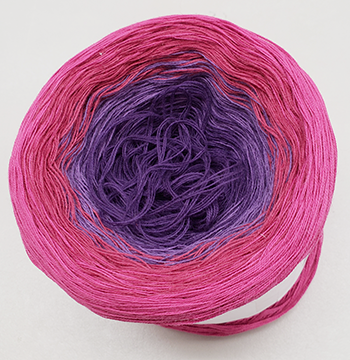
I have seen the nice results from friends who have knitted with this yarn, but what about weaving with it? Wouldn’t it make a fun shawl starting from one color and ending up with the other? I thought it would show best as weft.
Because a four-ply cotton can be dense, I decided that the warp should be lighter; silk is my go-to yarn to lighten up fabrics and I have lots of colors in my stash.
The cotton ball has 500 yards and wraps at 18 epi; with it, I figured I could make a 60” shawl about 18” wide, so my warp needed to be 20” and 97” long. I ended up winding 3 yards, to have some room to sample.
I chose a 20/2 purple silk; normally I would sett it at 24 epi for a twill (and this shawl needed to be a twill for drape), but because the 4-ply cotton is fatter, I calculated the sett to be 18 epi.
I wound about 5” of the solid purple; then I thought the warp needed sprucing up, so I wound 10” with a 20/2 purple and pink variegated silk for the middle and another 5” of solid purple for the other edge.
Next, the pattern: I wanted a twill for drape, I didn’t want a pattern to detract from the color changes and I wanted a twill I had not woven before (or at least that I remembered). That also meant that I could add it to the Pictionary! I browsed through Davison’s book and came across a crepe twill. Perfect!
Here is the shawl. I love the gradation!
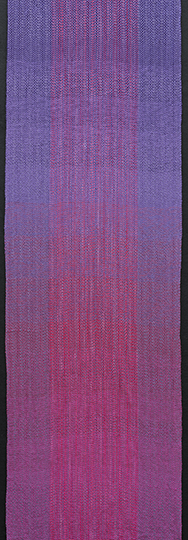
The drawdown and a close up of the fabric are in the Crepe Twill Pictionary page . If you have a Pictionary already, the Crepe Twill is new.
Pictionary update: in addition to the Crepe, all 21 additional twills are in the Pictionary now; 8 files for the finger manipulated weaves have also been added. They are located on this website under Pictionary; download all or those you are interested in.
I hope you enjoy your Pictionary. I welcome questions, corrections and additions any time.
Happy weaving!
Please email comments and questions to
A Pictionary
Marcy Petrini
July, 2018
A Pictionary is a dictionary with a picture, in this case of four-shaft weaving structures. I presented the concept at a Reno 2018 Convergence® seminar. Participants received a notebook with 66 entries in alphabetical order. My plan is to include all of those – a bit at a time – on my website for people to download as they wish.
The Pictionary will grow over time. At Convergence®, participants noticed that some structures were missing, and I have a “to do” list of others. In some cases, I simply ran out of time, and the structures will be coming soon; in other cases, my samples are of poor quality, so they will require reweaving. And I am sure that there are some structures I have never woven! Something new to try.
This month, the four structures that have been uploaded are the plain weave and its derivatives: plain weave, tabby, ribs and basket weave . Each of these four links points to a different PDF that will open in its own browser window. The rib entry has been edited from the Convergence® version.
Totally new this month is a ribbed twill, with samples from the Convergence® yarns, only one of which was completed before I left. So, if you have a Pictionary notebook, you can now add the Ribbed Twill.
In the future I also hope to include how to transform a structure from four shafts to more shafts.
At the seminar we also discussed two spreadsheets: one for planning and one for matching a project warp ends to structure repeats. Originally, I had planned to put those on the website for downloading, too, but I found out that it is not wise to have executable files (spreadsheets execute calculations) on the web site because they can be prone to mischief. However, I will be glad to email them just for the asking.
I hope you enjoy your Pictionary. I welcome questions, corrections and additions any time.
Happy weaving!
Please email comments and questions to
